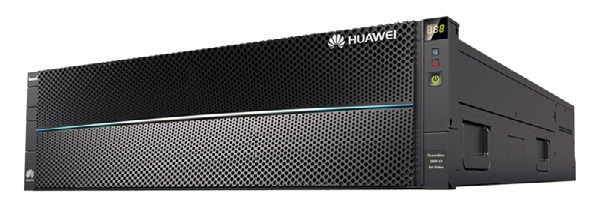Challenges:
- no data access continuity;
- the need to provide technical support outside work hours;
- limited expandability of the existing storage;
- insufficient space for data storage;
- high expansion costs for the existing storage solution;
- no storage infrastructure redundancy for individual server rooms.
Benefits:
- high availability of IT infrastructure;
- managing all storage arrays from a single console;
- instant and automatic IT environment switching from one storage array to another;
- 30-40% shorter backup time (smaller production data backup window);
- combining several pairs of disk controllers to increase computing power.
Solution components:
- two Huawei OceanStor 2600 V3 disk arrays;
- Huawei HyperMetro storage solution software functionality.
The project was implemented by experts working for Infonet Projekt, Huawei’s partner in Poland. The goal of the project was to increase the capacity of the storage system and to have the system components installed in two server rooms replicate data between each other. Such a solution, leveraging Hyper Metro functionality, was to provide high availability of the disk arrays cluster and ensure the continuity of the university’s systems.
The University of Opole was established in 1994 as a result of the merger of the Pedagogical University with a branch of the Catholic University of Lublin. Currently, it consists of 12 thriving faculties cooperating with other university units. Together, they create a dynamic, modern and versatile scientific and educational organism. The university in Opole has a huge scientific potential, generated by its award-winning staff and a multitude of specialized laboratories, as well as IT and media centers. The University of Opole makes a mark among other Polish universities by having the largest number of students per capita compared to other Polish voivodeships, despite Opole being the capital of the smallest of Polish voivodeships.
The existing storage array expandability problem
The university’s growing needs made it necessary to replace its storage systems. “We decided to take this step due to the need to increase the amount of space for data storage. The aim of the project was also to ensure high availability of IT infrastructure and to protect it against failures, along with the data we store,” remembers Slawomir Paszkiewicz, Linux systems and network services administrator working at the IT Center of the University of Opole.
“Initially, we wanted to extend the existing storage array we had bought two years earlier. However, it could not be done. The supplier suggested buying a new one with a larger capacity. So we decided that the new storage array must be supported for at least 5 years,” he adds. The University of Opole also wanted the existing storage arrays to be used after purchasing a new solution. In the end, Huawei OceanStor 2600 V3 solution was selected.

The storage arrays proposed by Infonet Projekt allowed to use the old storage systems. They were connected to Huawei devices and are now used to store data from non-critical systems. They are managed from the same console as Huawei solutions. “Thanks to this, our old arrays, which were previously unable to replicate, gained this functionality,” comments Slawomir Paszkiewicz. “Huawei solution was also the only one, at least within our specified budget, that offered the possibility of virtualizing the old arrays,” he adds.
Building a redundant IT environment
An additional requirement in the tender organized by the University of Opole was to ensure redundancy of the storage system. Huawei OceanStor storage systems operate in active-active mode. The selected solution offers the ability to easily, automatically, and almost instantly switch the IT environment from one storage system to another. As part of the implementation carried out by Infonet Projekt, a power failure in one of the facilities was simulated. The switchover from one Huawei array to another took so little time it was imperceptible to production systems. After restoring power, the storage arrays synchronized the data and continued to work, just as before the failure.
“The University of Opole chose Huawei storage systems with a total capacity of 40 TB each. The university representatives wanted to use them for VMware environment, among other things. Using the functionalities of VMware and Huawei storage systems, you can quickly and easily build high availability solutions,” says Kornel Kundzicz, IT Systems Architect at Infonet Projekt SA.

Pawel Witkowski, IT Systems Architect
Storage & Data Security Systems
“We have implemented a high availability cluster at the University of Opole using HyperMetro functionality. It connected two locations within the same campus. The university already had a redundant server environment. We provided the next level of reliability, this time for storage systems. More and more companies, especially those offering services for external users, pay attention to the necessity of having a backup infrastructure. This is what we used the HyperMetro functionality available in Huawei devices for. However, the backup infrastructure is not only used in the event of failure. It also allows you to carry out the necessary repairs or inspections during the day and not in the evening or on weekends. This is because, thanks to HyperMetro functionality, we can switch IT systems to a backup facility at any time,” explains Pawel Witkowski, IT Systems Architect at Infonet Projekt Storage & Data Security Systems department.
Ensuring uninterrupted access to IT systems
The data from all the IT systems used by the University of Opole, including websites, databases, and email, were transferred to Huawei OceanStor 2600 V3 arrays. “The applications that are critical to the University’s operation include the recruitment system. It has to run virtually non-stop. Students enroll in courses both before the summer and the winter semester. Additionally, the redundant IT infrastructure supports news services and the University Study Support System (Uniwersytecki System Obslugi Studiow, USOS). If these applications do not work, not only students but also most university employees have a problem. We also transferred the data from the finance and accounting and payroll systems to Huawei arrays. Each of these system has to work all the time,” says Slawomir Paszkiewicz.

Kornel Kundzicz, IT Systems Architect
Storage & Data Security Systems
The implementation itself, installing, configuring, and testing the new storage arrays, as well as data migration, took about a week. “The design was a step-by-step process, and made it easier to plan the implementation and the subsequent migration in advance,“ says Kornel Kundzicz. “The migration required us to think about how to distribute the existing and the new storage system resources between two server rooms. We wanted the resources to be identical in each of them. Then came the data migration. In the first stage, we moved the data from the old storage system to a Huawei array. In the next step, we transferred the less important data, such as test environments, to the old arrays. All the production systems run on Huawei OceanStor 2600 V3,” adds Slawomir Paszkiewicz.
Security of the IT environment security means the administrator’s peace of mind
One of the most important benefits of building a redundant storage environment based on Huawei storage systems is its improved security and the administrator’s peace of mind. Previously, the two server rooms operated separate IT environments. In the event of a failure in one of the facilities, an immediate intervention of the administrator was necessary, regardless of time, be it a night or a weekend. “I remember a Christmas Eve when we had an array failure. We had to work all day to fix it. Today, an automatic switchover to the backup facility allows us to avoid such situations, ” says Slawomir Paszkiewicz. The data is replicated between Huawei OceanStor 2600 V3 storage systems in both facilities in active-active mode. The same information is available in each of the server rooms of the University of Opole. “Concurrently, the backup time decreased by 30-40%,” he adds.
Another benefit of implementing Huawei storage systems, as pointed out by the representatives of the University of Opole, is the lack of disk space problems. “Before implementing the new storage environment, we already had only 600 GB of free space. Now, we have 15 TB in reserve. We also have a reserve of free slots for more disks that will quickly allow us to expand our storage with another 15-20 TB of space. At the same time we can buy another disk shelf whenever we want. Therefore, there is no problem with expanding Huawei OceanStor 2600 V3 arrays.” Slawomir Paszkiewicz concludes.
Online source: ITwiz